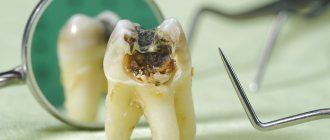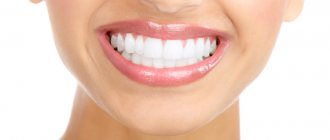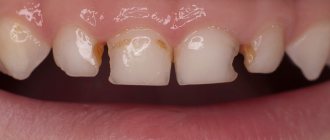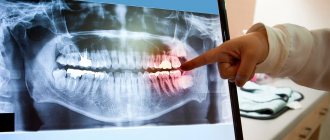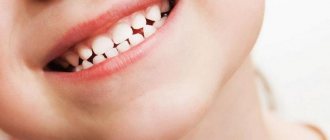Bad teeth in a child: reasons
A child’s baby teeth rot for various reasons.
Some are impossible to influence, others can be easily eliminated by dentists and caring adults. Most often, destruction of the enamel, and subsequently the coronal part of the primary occlusion units, is facilitated by:
- Disorders of intrauterine development of a child. Developmental pathologies are formed due to maternal toxicosis, non-compliance with nutritional recommendations, and the use of potent medications.
- Early birth of the baby. Prematurity of a baby indicates incomplete formation of internal systems - in particular, weak thin enamel of baby teeth.
- Antibacterial therapy administered to a child in the first year of life.
- Poor hygiene. Lack of systematic cleaning after the first tooth erupts, improper care, and inadequate parental control.
- Unbalanced child nutrition. Predominance of flour and sweets in the menu, lack of fermented milk and dairy products, hard fruits and vegetables.
- Reduced immunity. Congenital or due to a lack of vitamins in the diet.
- Diseases of the gastrointestinal tract, dysbacteriosis.
- Diseases of the endocrine system - diabetes mellitus.
- Previous infections - ARVI, chicken pox, scarlet fever.
- Pathogenic microflora entering the baby’s mouth from the outside. If family members have the habit of licking the baby’s spoon or pacifier, or kissing the baby on the lips.
- Poor ecology is a significant external factor that negatively affects the condition of the child’s teeth and general well-being.
- Heredity - parents or grandparents have bad teeth.
- Mechanical injuries, external damage to tooth enamel - cracks, small chips.
Causes
The exact causes of the development of erosion of tooth enamel in children have not been identified. The list of predisposing factors includes:
- exposure to acids, such as those found in carbonated drinks, citrus fruits, ketchups, sauces, marinades;
- pathology of the endocrine glands: the problem is often found in children with hyperthyroidism;
- excessive mechanical impact: bruxism, abuse of abrasive pastes.
These factors can serve as an impetus for the development of pathology, as well as provoke the growth of existing defects.
How to determine if a child has bad baby teeth
A child's rotten front teeth are immediately visible. These are dark or yellow spots of enamel, reddened gums, and damaged edges. But sometimes decay begins on the distant teeth - molars, premolars, and then you need to focus on indirect signs.
The fact that a child is growing bad teeth is indicated by:
- complaints of pain and discomfort - reaction to toothpaste, hot or cold foods;
- unpleasant odor from the baby’s mouth - putrid, pungent;
- change in enamel color - the appearance of dark stripes, yellow or dark spots;
- development of dental diseases - caries, pulpitis.
Any of the listed factors indicates the need for consultation with a pediatric dentist - a full diagnosis and timely treatment.
Prognosis and prevention
With adequate treatment, tooth erosion becomes much smaller, and the enamel structure is restored. After severe symptoms disappear, children should visit the dentist regularly to prevent relapse. It is recommended to minimize the consumption of products that can increase the destruction of enamel.
Erosion of tooth enamel can occur even in a child. So that the baby does not experience pain when eating and does not feel embarrassed to smile, you need to consult a dentist in time. Experienced specialists at the SM-Doctor clinic will carry out all the necessary diagnostics and select the optimal way to restore the normal structure of the enamel.
Stages of decay of children's milk teeth
A child’s bad teeth almost always mean caries. The disease is distinguished by the type and depth of tissue damage. Dentists highlight:
- Initial and superficial caries is the primary destruction of the enamel, manifested as white spots.
- Visible carious lesions are medium and deep caries. Teeth rot quickly and stains develop into cavities. The child begins to experience pain. An unpleasant odor appears from the mouth.
- Circular caries is the circular destruction of enamel and dentin near the gums. If left untreated, the tooth breaks and rots further to the root.
In particularly advanced situations, damage covers an increasingly larger volume of tissue, leading to serious pain and loss of the milk unit.
Classification and stages of development of tooth enamel erosion in children
Depending on the depth of the lesion, three degrees of the disease are distinguished:
- initial: only the top layer is affected;
- medium: the pathological process involves the entire enamel;
- deep: destruction affects the upper layer of dentin.
The activity of the process allows us to distinguish two clinical stages of erosion development. In the active stage, relatively rapid destruction occurs: defects spread over the surface and become deeper. The enamel takes on a matte appearance, and in severe cases changes color to yellowish. In the stable phase, the teeth are not externally changed, there are no obvious symptoms, but when examined under a microscope, the lesion is clearly visible.
Bad teeth in a child: how to treat
Decay of baby teeth can be stopped. Especially if the parents quickly assessed the threat and brought the child to the children's dental clinic. Treatment options are different:
Remineralization of tooth enamel
The doctor will apply a special gel to the baby teeth, which contains minerals to strengthen the teeth. Usually it is calcium, phosphorus, fluorine. The substances will restore the enamel structure at an early stage of destruction, but if the teeth are already rotting, the dentist will select a different treatment.
Sealing
Cleaning out carious cavities and then installing a filling. The preparation method is selected according to the patient’s age. Modern dental clinics treat teeth without a drill - using the ICON method, as well as using classical methods.
Ozonation of teeth
A method of disinfecting destroyed cavities followed by filling, when ozone is used to eliminate pathogenic microflora. The treatment has proven itself to work with children's rotten teeth, but is only suitable for moderate decay.
Laser therapy
The disinfectant effect of a laser beam is an excellent way to disinfect a small cavity and remove bacterial microorganisms in the mouth of a young patient. Suitable for the treatment of moderate caries of primary teeth.
Removal
A radical method of dealing with rotten teeth of a child. Used when it is impossible to carry out therapy and save teeth.
Rodikova Tatyana
When parents are interested in why their child has bad teeth, I first of all ask about nutrition. Almost all children today eat sweets, chips, and drink soda without restrictions. Of course, this negatively affects the teeth. The second common reason is heredity. Congenital diseases and medications are less likely to damage teeth.
Treatment for crumbling teeth
The method of treating tooth decay depends on the cause of this process. If it is caused by general somatic or chronic diseases, the dentist may involve specialized specialists in treatment. In addition, organizing a balanced diet and generally strengthening the immune system are of great importance. To restore damaged teeth, photopolymer filling materials are usually used, and in case of significant destruction, teeth are restored with artificial crowns.
At the ARTOX dental clinic, you can always get advice from a qualified dentist about crumbling teeth in patients of any age and carry out a course of treatment. The experience of our specialists and advanced technologies will allow you to eliminate problems effectively and safely.
Make an online appointment with a doctor or call: +7,.
View prices
Making an appointment with a dentist
Why treat baby teeth?
Rotten baby teeth do not always attract the attention of parents. Especially if the pathological processes are painless and do not bother the child. Adults think that when the bite changes, the bad teeth will disappear by themselves, and instead of rotten teeth, normal molars will grow. Dentists warn about the fallacy of such a misconception.
Rotten milk teeth are:
- damage or destruction of tooth germs - a high risk that the root units will grow sick or not appear at all;
- early loss of primary occlusion units - leads to displacement of existing teeth, the appearance of crowding, and the formation of a pathologically abnormal bite;
- an ugly smile, an unaesthetic appearance - the appearance of complexes due to appearance in young children, decreased contact with peers, uncertainty, isolation;
- deterioration of diction - rotten, breaking teeth interfere with the correct movements of the tongue during speech, leading to a lisp, burr;
- gradual spread of infection - damage not only to the surface of the teeth, but also to the pulp, development of pulpitis, the appearance of an abscess, as well as a tendency to ENT diseases and gastrointestinal diseases.
Possible complications
Complex injuries can often have serious consequences, manifested in complications. It doesn’t matter which tooth was injured – the front incisor, the chewing tooth. After the examination, the doctor will decide how to save the child’s tooth. If you neglect the recommendations of a specialist, this can lead to more serious consequences, not to mention aesthetics.
Types of complications
1. Possibility of infection of the pulp area.
2. Increased tooth sensitivity.
3. The appearance of a bend in the tooth root.
4. Violation of occlusion.
5. Formation of cysts and granulomas.
You need to prepare for the fact that a damaged child’s tooth will begin to change the angle of development. And this leads to deformation not only of the damaged tooth, but also of its healthy neighbors. If it is necessary to remove a broken tooth, the space must be filled with an implant. If filling is not carried out, other teeth will begin to shift and move closer together, which leads to occlusion disorders - bite.
How to prepare your child for an orthodontic appointment
The initial appointment with an orthodontist takes place without any preparation. The child just needs to brush his teeth and eat beforehand. The latter is desirable, as it will help reduce salivation and facilitate the examination procedure. The child should also be told about the doctor’s specialization. In simple words, explain who this pediatric orthodontist is and what he treats.
An orthodontic examination is a painless procedure. It does not cause fear or discomfort in the baby, but it helps to identify deviations in the development of the dentition as early as possible.
Soldatenkova Alina
Typically, the removal of decayed milk teeth involves the extraction of several units at once. At Azabuka, we recommend performing this procedure under anesthesia or sedation. It is completely safe for the child, and most importantly, it does not leave traumatic, unpleasant memories in the child’s memory.
Other causes of enamel darkening in children
Rotten baby teeth in a child look different in the photo. Usually these are black spots, lumpy enamel, deformed crowns - unpleasant, ugly, even creepy. But an unaesthetic appearance does not always indicate rotting. Sometimes the reasons lie in other diagnoses or pathologies:
- black plaque;
- enamel hypoplasia;
- abnormalities in tooth shape.
Black plaque - stains on baby teeth
Dark spots on teeth are not always tooth decay. It could also be:
- Priestley's plaque - appears due to the increased activity of certain bacteria that secrete a black pigment. The defect is aesthetic, but dentists advise cleaning the enamel from plaque, since it can prevent caries or other dental diseases.
- Dark deposits due to taking iron supplements are an aesthetic problem, which professional cleaning helps to cope with.
Dark pigmentation is also caused by dysbiosis, lack of calcium, and taking antibiotics. Plaque is removed using gentle dental cleaning methods, returning the enamel to its natural whiteness.
Enamel hypoplasia and tooth shape abnormalities
Hypoplasia manifests itself as a change in the structure and color of the enamel and is not a carious lesion. Is it congenital or acquired? In the case of systemic hypoplasia, the shape of the dentition units may also be affected. Externally, the pathology manifests itself as:
- an altered line of the tooth edge is a natural deformation, and not due to rotten teeth;
- barrel-shaped crowns, cone-shaped - due to changes in the tooth at the dentin level;
- spots on the tooth surface of different sizes and shades - altered enamel thickness, insufficiently developed tissues.
For isolated manifestations, hypoplasia is not treated. In case of severe defects in baby teeth, the doctor will suggest remineralization and filling of the affected areas.
Diagnostics
For a basic diagnosis, a dental examination is sufficient, during which the doctor identifies characteristic changes in the appearance of the enamel. To clarify the diagnosis, a drying test (iodine test) is performed. In some cases, microscopic examination and x-rays are used. As a rule, at the same time, the child is sent for a consultation with an endocrinologist or gastroenterologist to rule out stomach pathology, accompanied by the reflux of acid into the oral cavity, or diseases of the thyroid gland.
How to protect your child's teeth
Among the main preventive measures for the preservation of teeth in children of any age are:
- Maintaining oral hygiene to prevent plaque formation - timely care, selection of toothbrushes and toothpastes according to age, professional cleaning using gentle methods.
- Good nutrition - creating a varied menu that will include yoghurts, kefir, cheeses, vegetables and fruits.
- Selection of a vitamin complex according to age - independently or after consultation with a pediatrician.
- Timely visits to the dentist - pediatricians recommend coming for scheduled appointments every 4-6 months. This helps to identify caries and enamel destruction at an early stage and save teeth from serious problems.
- Fissure sealing - smoothing the lumpy surfaces of molars and premolars to reduce the risk of caries and rotting of distant units.
Rodikova Tatyana
Parents often have to explain: it doesn’t matter when the child’s bad teeth appeared - at 3 years old or at 7 years old - they need to be treated. Waiting until they fall out on their own is a big risk. Fortunately, in most cases the explanations work and we begin treatment. It's nice to see how a child's face changes when he sees beautiful, even, snow-white teeth in the mirror - instead of rotten and black ones.
It is also worth carefully monitoring the mechanical integrity of the teeth, since any crack or chip is a potential threat to the child’s dental health.
The health of children is the concern of parents. Poor heredity, diseases, premature birth indicate the need for careful monitoring of the condition of teeth - timely prevention and treatment. If everything is done correctly, then the child will not have rotten teeth, but only a joyful and beautiful smile.
Prevention of tooth decay
To strengthen tooth enamel, you need to:
- comply with oral hygiene standards;
- consume less sweets, rinse your mouth regularly after sour or spicy foods;
- Be sure to come for preventive examinations at the dentist twice a year, have professional cleaning and strengthening procedures;
- monitor your diet;
- stop smoking and bad habits (do not bite hard objects and nails);
- Drink only clean drinking water.
